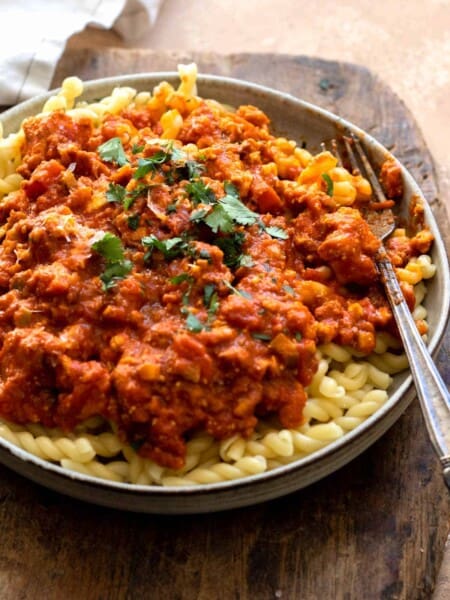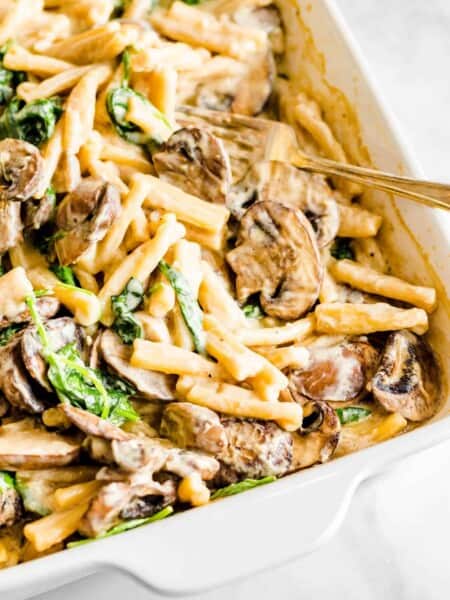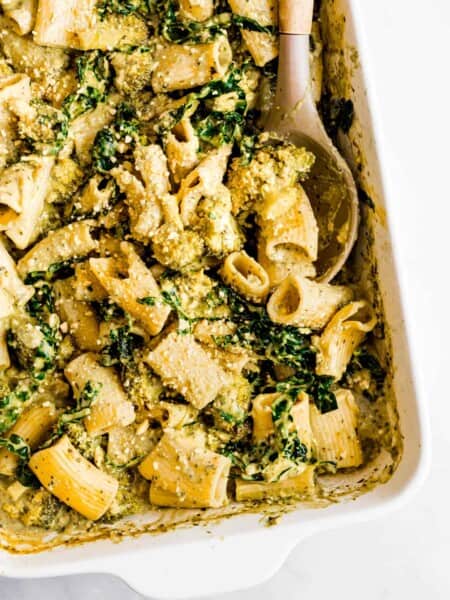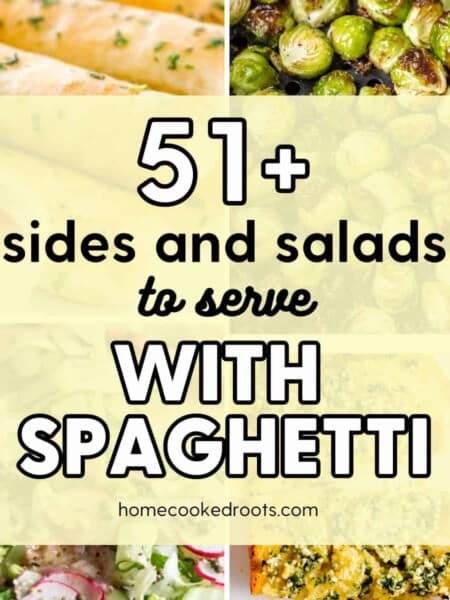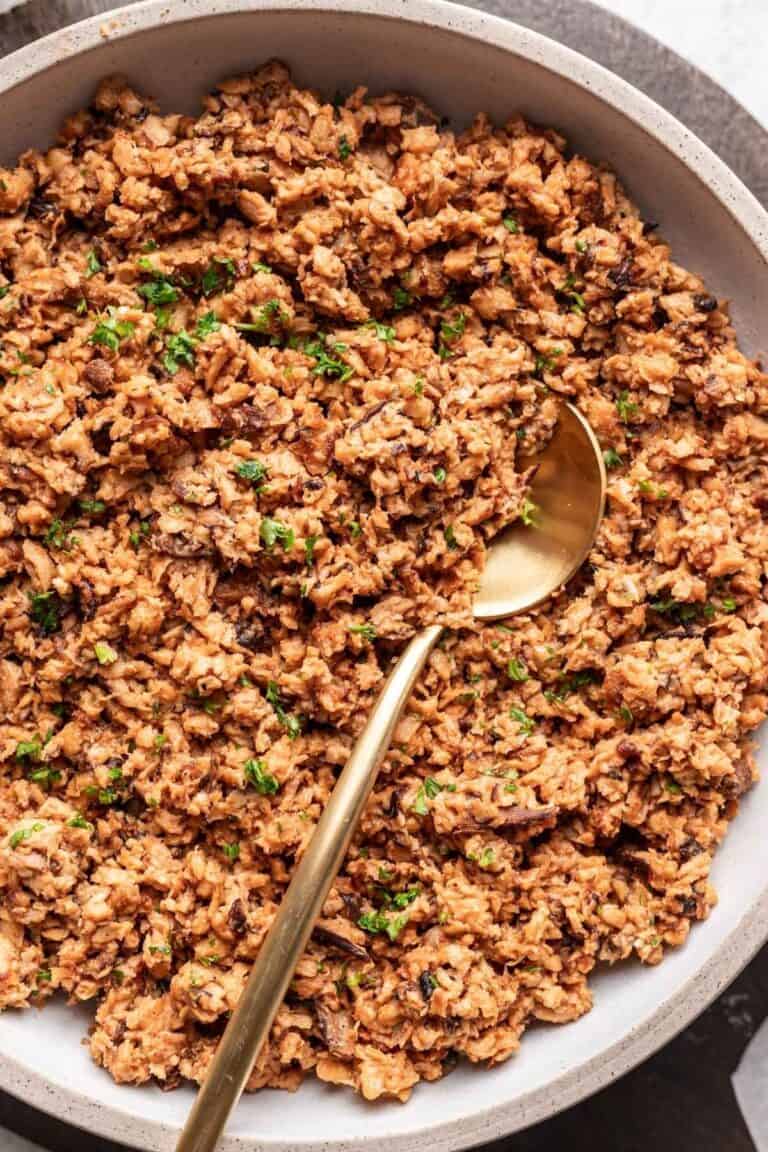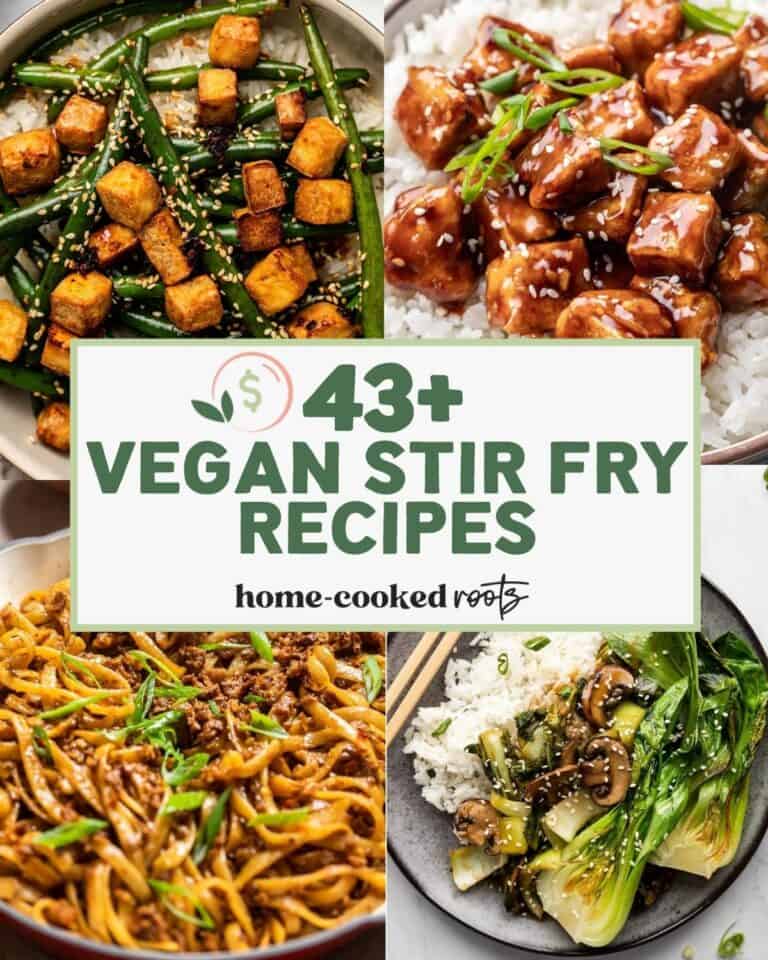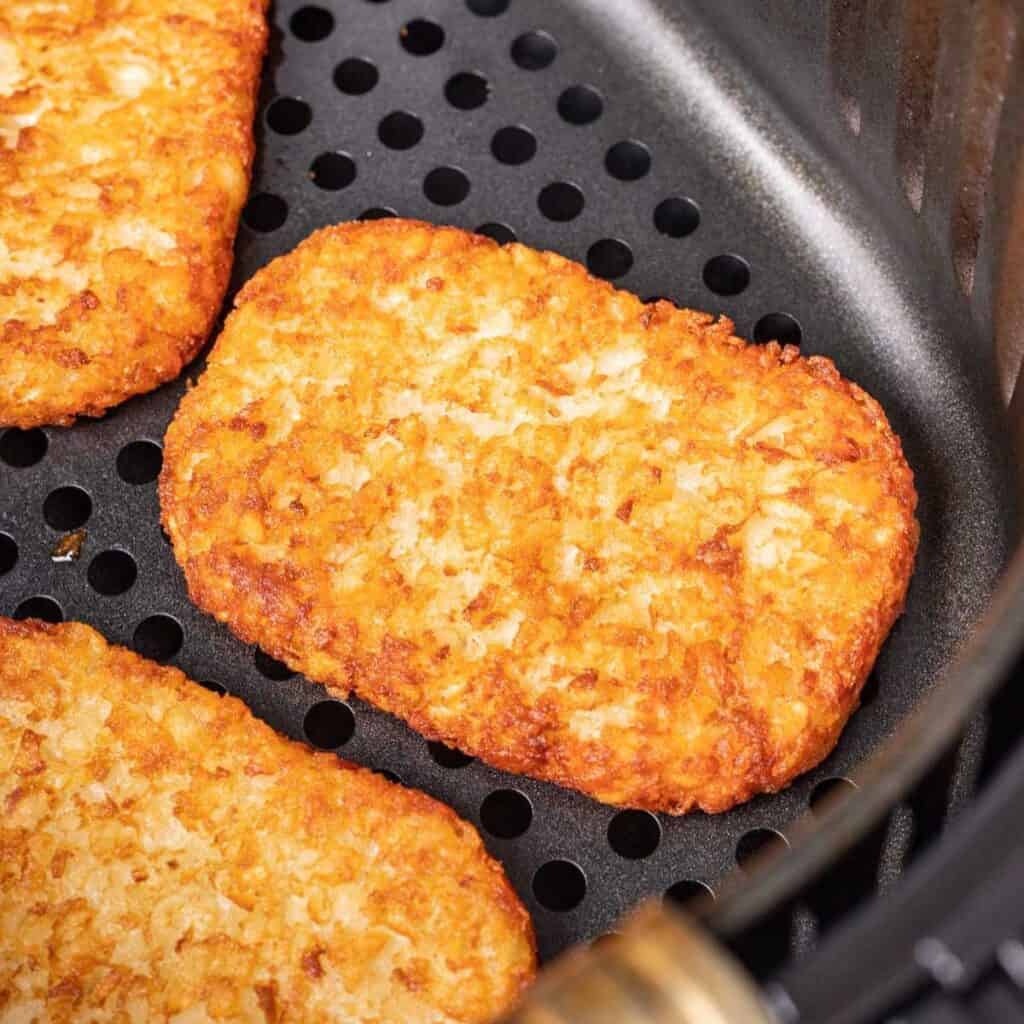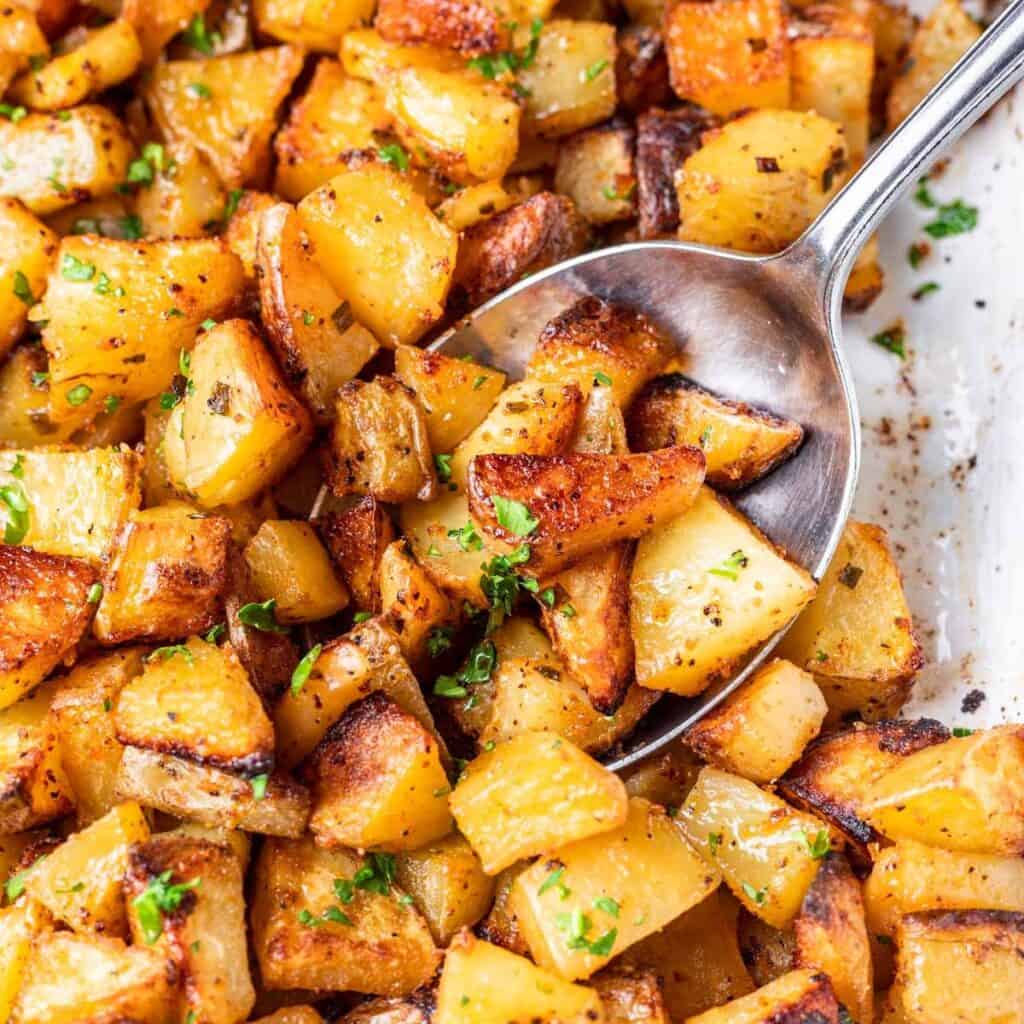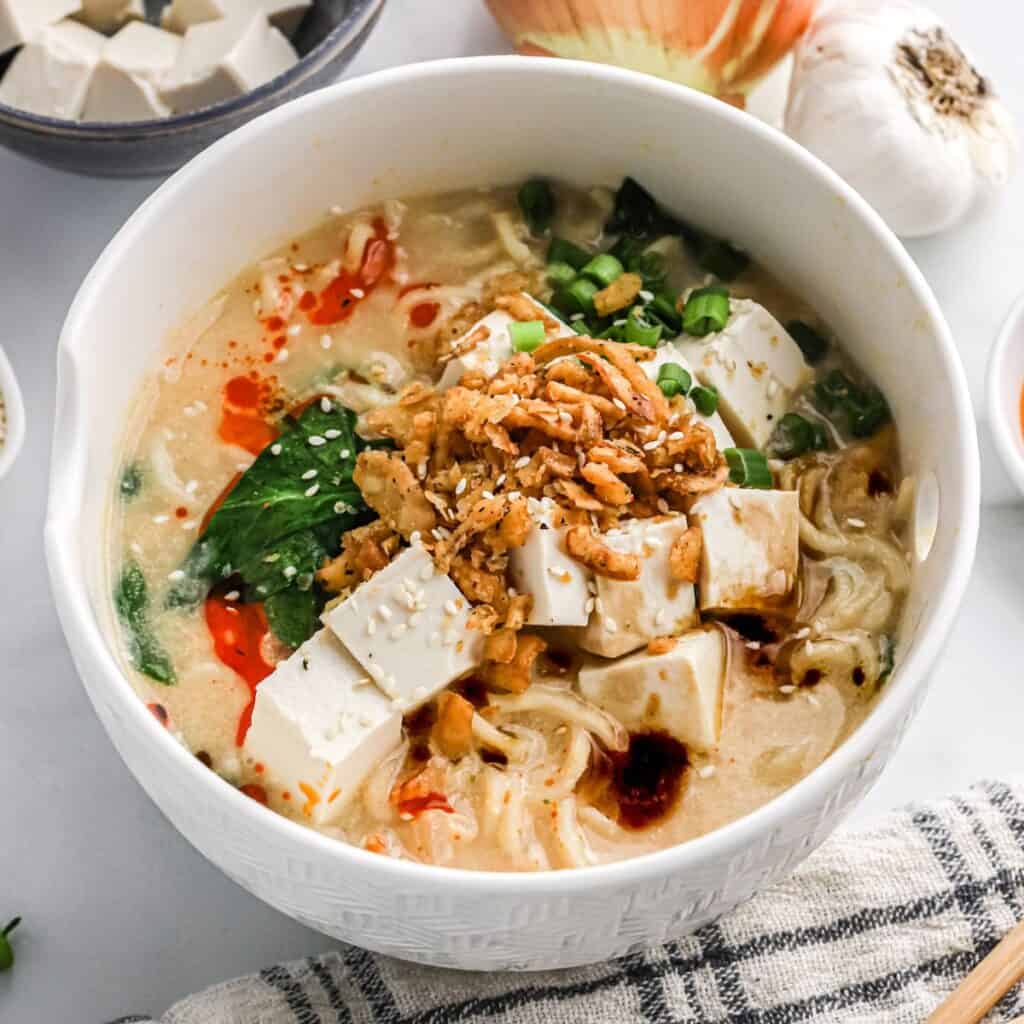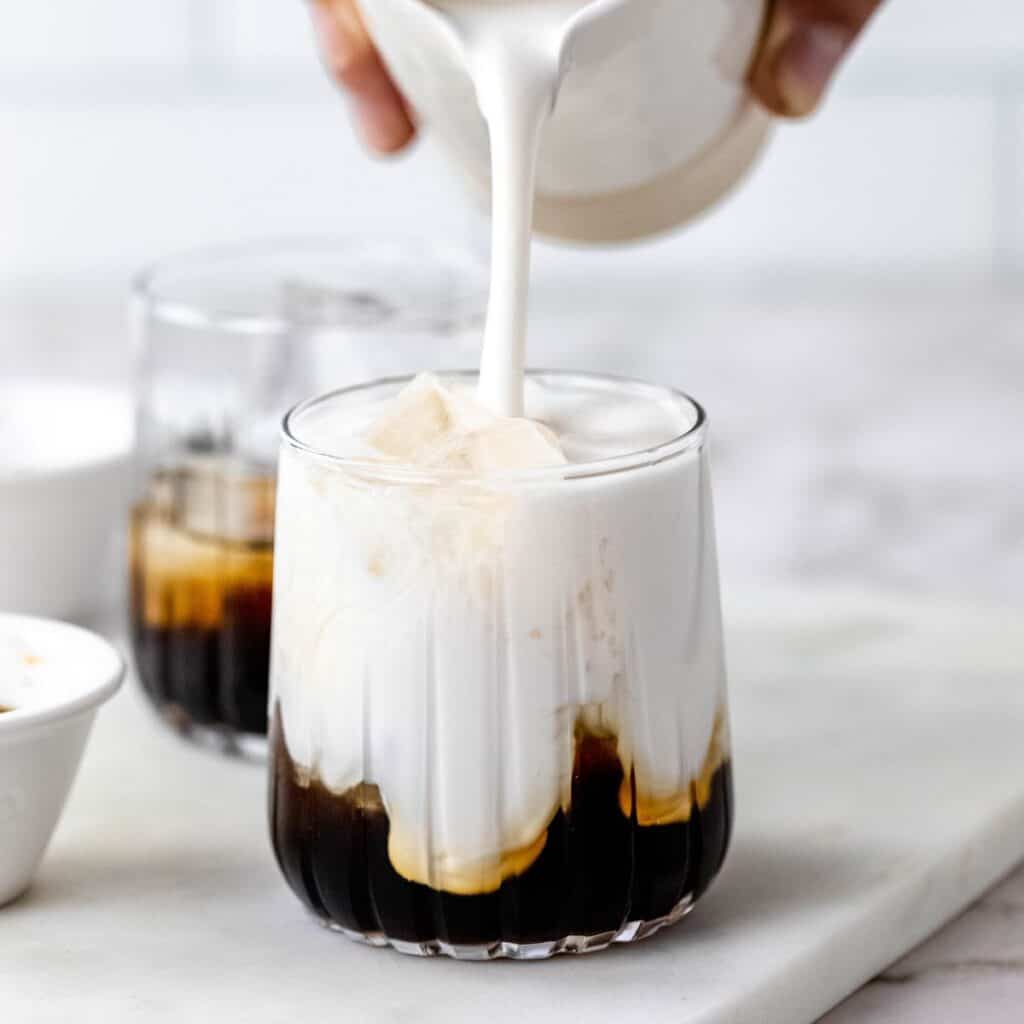This post may contain affiliate links. By browsing this website, you agree to our privacy policy and terms of use.
Here’s 10 of the best plant-based pasta brands in terms of protein, texture, and value. Plus, I’m giving you all of my tips and tricks for scoring these pastas for as cheap as possible. Try one of these brands on your next pasta night with your favorite sauce and veggies!
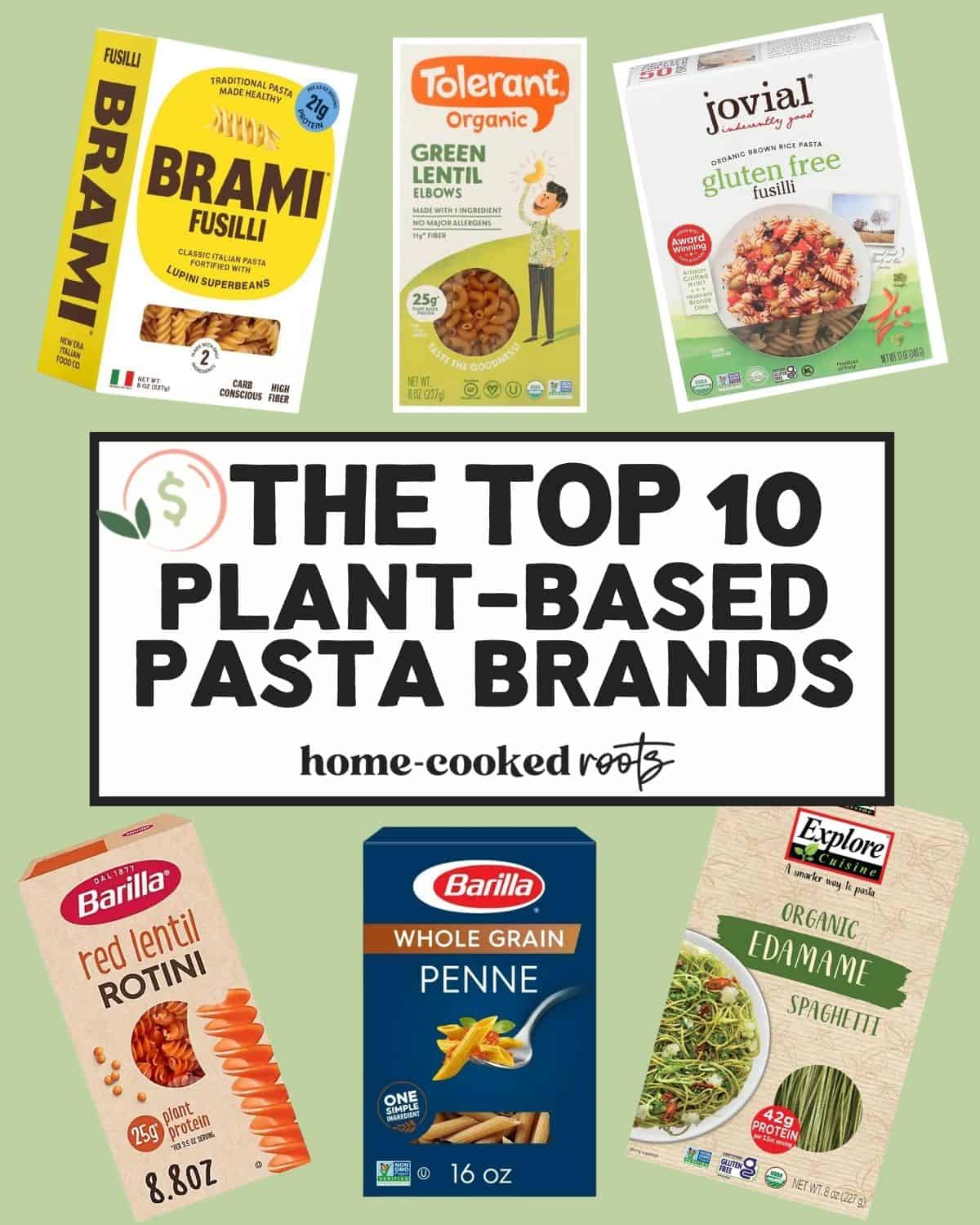
Most pasta is plant-based, right? Yes, most commercially available pasta is plant-based, though you should watch out for brands made with egg (read those ingredients labels).
Pasta is a great staple in a budget-friendly plant-based diet (it’s also a fantastic pantry staple). It’s loaded with carbohydrates and, depending on the kind you get, protein and even fiber. The plant-based pasta brands I’ll talk about below are some of the “healthier” brands, meaning they have more protein, fiber, etc. because of the composition of the pasta itself.
If you’re on a shoestring budget (or simply love being frugal!), I’ve got a few tips to help you purchase pasta for as cheap as possible:
Tips for Purchasing Pasta for Cheap!
- Without sales our coupons, regular ol’ white pasta will always be your cheapest option. This is your standard pasta made with refined flour. It has minimal protein, but it’s absolutely the most affordable option and is an excellent source of carbs to help keep you full. In 2024, Walmart’s standard great value pasta varieties are about $1.18 per pound. There is nothing wrong with exclusively enjoying this type of pasta!
- Shop at discount grocery stores. I live on the West Coast and my favorite discount grocery store is Grocery Outlet. This is where I shop for all of my specialty or “healthy” legume-based pastas and find them for as low as $0.99 per box! If you are on a budget, PLEASE check your local discount stores and score major deals on these higher end products.
- Check the weekly ads. Every Wednesday, grocery stores put out their new weekly ad where they feature the best discounts of the week. Shop these ads to find deals on your favorite pastas.
- Buy in bulk. If you eat pasta on the regular, buying it in bulk from stores like Costco is very cost-effective. Costco also has a policy where if something goes on sale (sometimes up to 3 months after you purchased it) you can get a refund for the difference!
- Avoid buying on Amazon when possible. Below I’ve linked the following brands recommendations to allow you to shop on Amazon, BUT I highly recommend shopping your local area first. Amazon is very convenient and accessible to most, but it is usually never the cheapest option (far from it when it comes to pasta!).
Plant-Based Pasta Brands
Save this post for later and add some of these plant-based pasta brands to your shopping list! These brands can all be purchased online on Amazon (affiliate links below!), but remember, shopping in person is almost always a significantly cheaper option!
Next, browse my favorite recipes to Serve with Spaghetti (51 Sides and Salads!).
1. Trader Joe’s Red Lentil Pasta
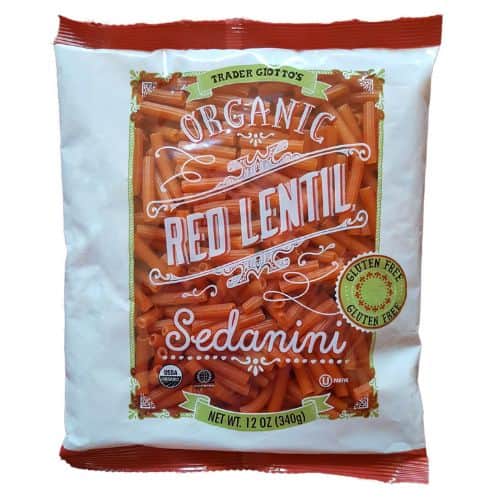
Trader Joe’s Red Lentil Pasta
If you have a Trader Joe’s near you, definitely check out their red lentil pasta (you can also sometimes find Trader Joe’s products on Amazon – linked above)!
It only comes in one shape (sedanini) but at only $2.99 USD a bag (that’s a decent retail price for legume-based pastas!), it’s pretty great.
Of all the legume pastas I’ve tried, this one is my favorite texture and flavor-wise. One serving (2 ounces) of this single ingredient pasta packs 6 grams of dietary fiber, 36 carbohydrates, and a staggering 15 grams of protein. So if protein’s your goal, definitely give this awesome product a try.
2. Banza Chickpea Pasta
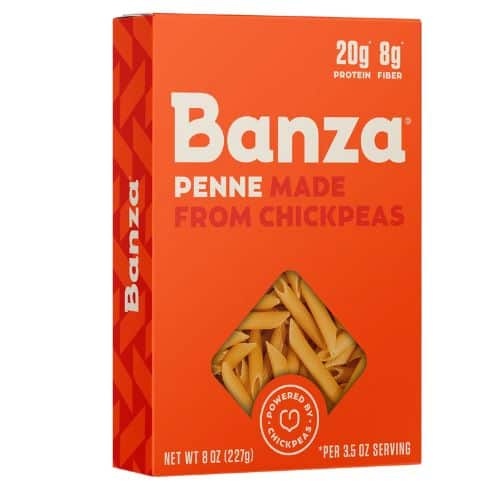
Banza Chickpea Pasta
Banza is a well-known chickpea pasta brand. Most of their pasta contains four ingredients: chickpeas, pea starch, tapioca, and xanthan gum. While the calories per serving are pretty similar with wheat pastas (around 200 calories for a 2 ounce serving) the carbs are slightly lower and the protein is definitely higher (around 11 grams of protein per serving).
They also appear to have a decent amount of dietary fiber at about 5 grams of dietary fiber per serving. In terms of taste, Banza has a strong unpleasant flavor if you eat it plain, but who eats plain pasta? It’s great once you add your favorite pasta sauce, like my Veggie-Packed Spaghetti Sauce Recipe (no meat!). It has a good texture and I definitely enjoy it.
At the time of writing this, Banza also offers other products such as frozen pizzas and crusts, boxed mac and cheese (vegan and non-vegan), rice, and even waffles!
3. Tolerant Legume Pastas
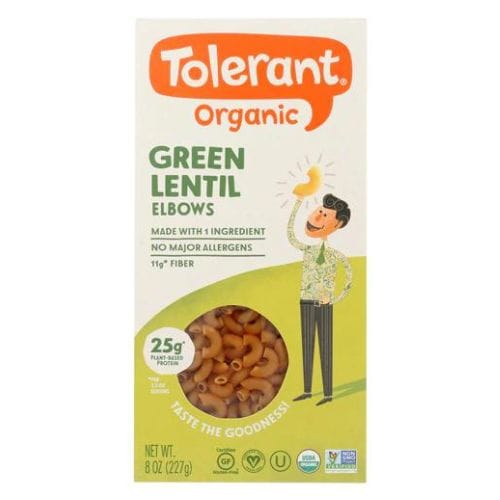
Tolerant Legume Pastas
Tolerant makes single ingredient legume pastas (all gluten-free) including chickpea pasta, red lentil pasta, and green lentil pasta. It’s worth pointing out that they also make kid-friendly shapes Alphaland, Safari, and Galaxy.
Tolerant lists their serving size at 3 ounces. One serving of their chickpea pasta will get you 9 grams of dietary fiber, 17 grams of protein, and 51 carbohydrates. Their green lentil pasta has better protein at 21 grams per serving, plus 9 grams of dietary fiber and 53 grams of carbohydrates. Their red lentil pasta is similar at 21 grams of protein, 9 grams of dietary fiber, and 50 grams of carbohydrates per serving.
4. Barilla Whole Grain Pasta
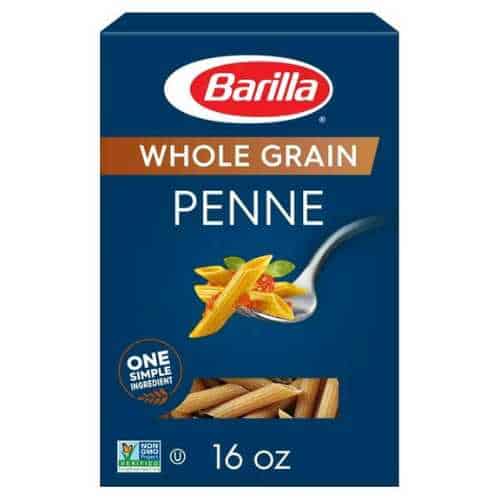
Barilla Whole Grain Pasta
Barilla makes many different types and varieties of pasta, but they do have a small whole grain line (with shapes like elbows, thin spaghetti, rotini, and penne).
Their whole grain pasta contains 6 grams of dietary fiber per serving (3 times the fiber of traditional white pasta) and 11 grams of protein which is the same as Banza. It depends on which you like better and what your goals are.
I actually like the texture of whole grain pasta better. If you’re watching your carbohydrates, though, the bean and legume pastas are typically better in that area. If you’re looking to save money, whole grain pastas are typically cheaper than bean and legume pastas. Cheaper still are store brands.
5. Barilla Legume-Based Pastas
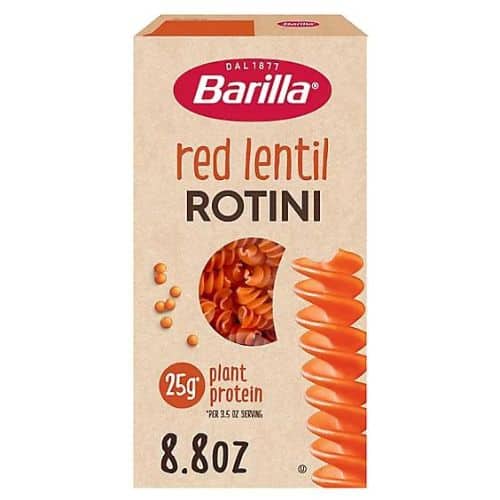
Barilla Red Lentil Rotini
It’s also worth mentioning that Barilla makes legume pastas! They make both chickpea pasta and red lentil pastas, each of which are made with only one ingredient: chickpeas or red lentils.
The protein content is the same as their whole grain pasta (11 grams per serving), but the dietary fiber is at a whopping 8.5 grams of protein per serving.
If you’re watching your carbohydrates, Barilla’s legume pastas are definitely lower carb than their whole wheat or traditional white pasta, but Banza appears to be better in this category.
6. DeLallo Whole Wheat Pasta
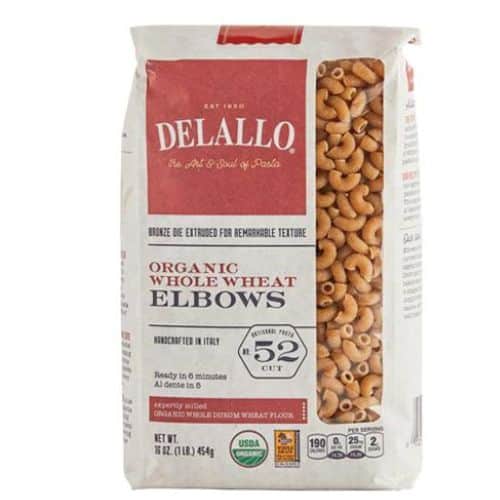
DeLallo Whole Wheat Pasta
DeLallo is my favorite brand of pasta. It’s a little bit pricier (at the time of writing this, $3.95 USD a pound via their website, and they frequently run good sales), so I consider it a special treat.
At the time of writing this, DeLallo does not make legume pastas. If you are gluten-free, they do make gluten-free pastas but I have not tried them (but everything I’ve tried from them has been amazing, so it might be worth a shot.
DeLallo whole wheat pasta comes in a variety of shapes including orzo, lasagna, linguine, and farfalle (bowties), which set them apart from other whole wheat pasta brands. For a 2 ounce (dry) serving, DeLallo whole wheat pasta contains 7 grams of protein, 4 grams of dietary fiber, and 37 grams of carbohydrates.
Their whole wheat pasta has the lowest carbohydrate content I’ve seen in a wheat-based pasta, but you’ll probably get more protein from a legume-based pasta.
7. Brami Lupini Bean Pasta

Brami Fusilli Pasta
Brami makes lupini bean snacks, but they’ve recently started making pasta. Brami pasta is made with two ingredients: semolina wheat and lupini beans. This does make them unsuitable for gluten-free folks, unfortunately.
But if you can have gluten, the nutrition on this pasta looks pretty great. For a 2 ounce serving, you can get 12 grams of protein and 6 grams of dietary fiber (and only 35 carbs which is significantly lower than other pastas).
The semolina flour ingredient does help this pasta have a better texture, though I thought other bean based pastas were a little better. I think it’s highly subjective though, so it’s definitely worth a try.
8. Jovial Pasta: Gluten-Free, Cassava, or Einkorn
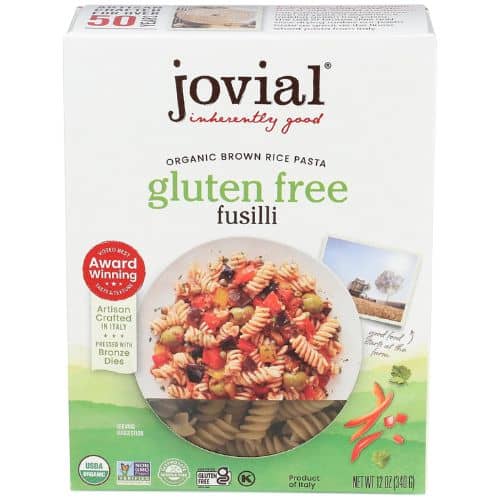
Jovial Gluten Free Fusilli
Jovial makes a variety of pastas in three different categories: gluten-free brown rice pasta, organic einkorn pasta, and grain-free cassava (cassava is a starchy vegetable) pasta.
They’re pricier at around $5 USD (at the time of writing this) for 12 ounces. We’ll start with the gluten-free pasta. For a 2 ounce (dry) serving, you’ll get 5 grams of protein, 2 grams of dietary fiber, and 44 grams of carbohydrates.
Next, for a 2 ounce (dry) serving of Jovial organic einkorn pasta, you’ll get 7 grams of protein, 2 grams of dietary fiber, and 40 grams of carbohydrates. Finally, for a 2 ounce (dry) serving of their grain-free cassava pasta, you’ll get only 1 gram of protein, 4 grams of fiber, and 49 carbohydrates.
9. Explore Cuisine Legume Pasta
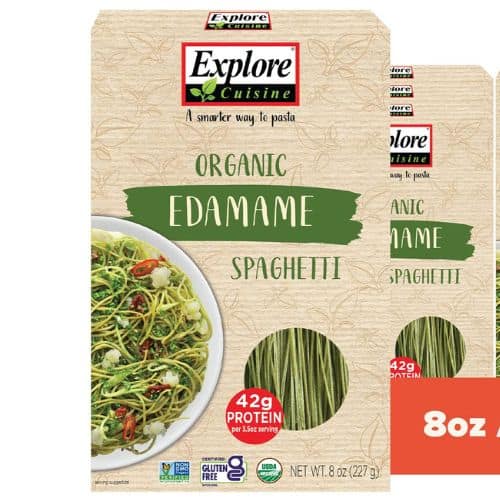
Explore Organic Edamame Spaghetti
Explore Cuisine makes a variety of legume pastas in varieties like edamame pasta (or edamame & mung bean), black bean pasta, chickpea pasta, and red or green lentil pasta. We’ll talk about the edamame pasta since it’s one of their more unique products.
For a 2 ounce (dry) serving, you’ll get a whopping 24 grams of protein, 13 grams of dietary fiber, and for only 20 carbohydrates. This brand perhaps wins for its macros (depending on your nutrition goals), but I haven’t personally tried it so I can’t speak to the texture. Give it a try!
10. Lotus Foods Rice Noodles and Rice Ramen
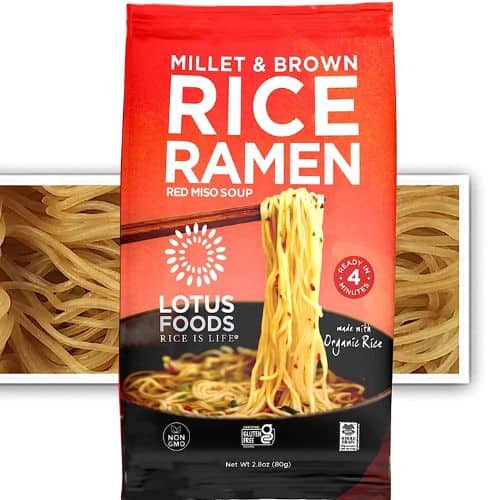
Millet and Rice Ramen Noodles
Some may argue with me for putting noodles in a plant-based pasta brands article. I understand the distinction. But if you’re looking for plant-based pasta brands, you might also be looking for plant-based noodle brands and you might want to consider Lotus Foods!
They make noodles in several different varieties. Their ramen and rice noodles come in a variety of styles. I’ll share the macros of my favorite product, their millet & brown rice ramen, but keep in mind that the nutritional content varies from product to product.
For a half dry ramen cake (about 35 grams), you’ll get 4 grams of protein, 2 grams of dietary fiber, and 23 grams of carbohydrates.
Vegan Pasta Recipes to Try
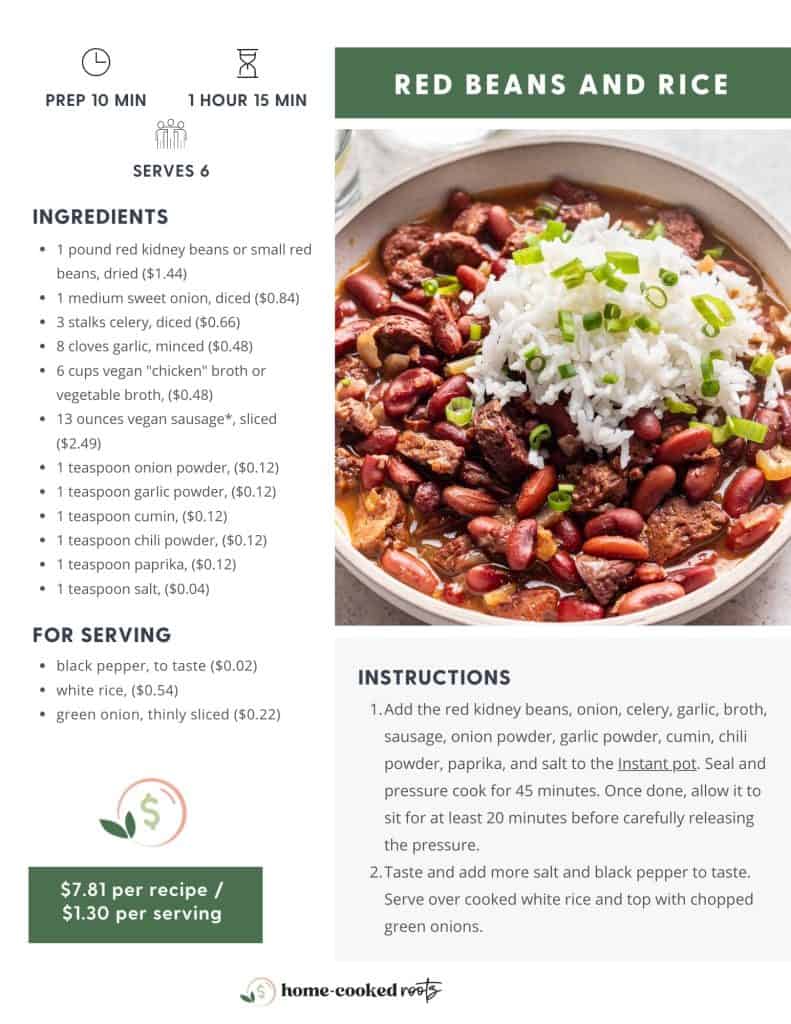

Free ebook
Wallet-Friendly Recipes & Smart Shopping Tips in Your Inbox
Plus get a free cookbook with 12 Dirt Cheap Dinner Ideas that’ll cost you $2 or less per serving.
